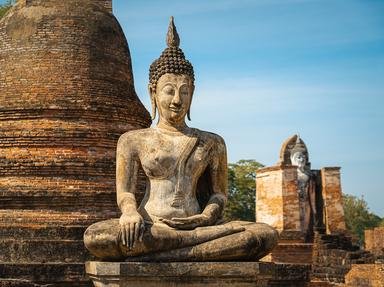Quiz Answer Key and Fun Facts
1. The photo shows a cast of a famous statue by Auguste Rodin from 1889 that stands in the lea of the Houses of Parliament in London. The statue commemorates events that occurred during the Hundred Years War in which French city, where the original statue still dominates the central plaza?
2. Built between 2003 and 2010, the 144-foot tall Kailashnath Mahadev Statue is the world's tallest statue of Shiva, one of the three major Hindu deities. To which country must you travel to see this statue?
3. Erected in 1865, this statue of the explorers Burke and Wills is the work of English-born Australian sculptor Charles Summers (1825-78). It can be seen at the corner of Collins and Swanston Streets in which Australian city?
4. Originally sculpted for the promotion of the 1982 film "Rocky III", this 10-foot tall, 2-ton statue by A. Thomas Schomberg depicts Sylvester Stallone as Rocky Balboa. Until the stadium was demolished in 2011, it stood outside the Wachovia Spectrum in which U.S. city?
5. Modelled by Gustav Vigeland in 1924, "The Monolith" is the centrepiece of the 58 statues that comprise the "Vigeland Installation". This amazing collection is located within Frogner Park, now a major tourist attraction in which European capital city?
6. Viewed here with the city skyline in the background, the "Merlion" is a mythical creature with the body of a fish and the lead of a lion. The "Merlion" was moved to its current location, in front of the Fullerton Hotel overlooking Marina Bay, in 2002. In which Asian city can this statue be seen?
7. Everyone is familiar with Nelson's Column in London's Trafalgar Square. Less famous is the Duke of York Column which, at 137' 9", is just 18 inches shorter than its more famous neighbour. Completed in 1834, near which famous London thoroughfare does the Duke of York Column stand?
8. We return to the USA for our next example which, at 56-feet tall, was the world's largest statue made from cast iron when it was made in the early 20th century. This is the Statue of Vulcan: no, not Mr Spock, but the Roman god of fire, volcanoes and metalworking. Which U.S. state must you visit to see this statue?
9. 'Fontana dei Quattro Fiumi' ("Fountain of the Four Rivers") is a spectacular work by the creator of the Baroque style of sculpture, Gian Lorenzo Bernini (1598-1680). The base of the fountain represents the four 'River Gods' overlooked by an Egyptian-style obelisk. This statue is situated in the 'Piazza Navona' in which Italian city?
10. This magnificent 49-foot tall statue of George V, King of Great Britain and Emperor of India, is the tallest of any statue of him in the world. It originally stood outside India Gate, but following India's independence in 1947 it was moved to its current location adjacent to the Memorial Obelisk in Coronation Park. In which Indian city can this statue be seen?
Source: Author
EnglishJedi
This quiz was reviewed by FunTrivia editor
stedman before going online.
Any errors found in FunTrivia content are routinely corrected through our feedback system.

